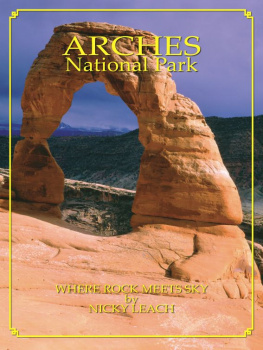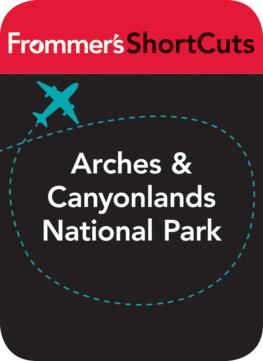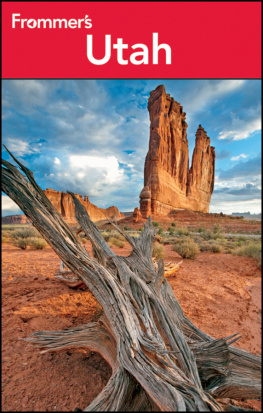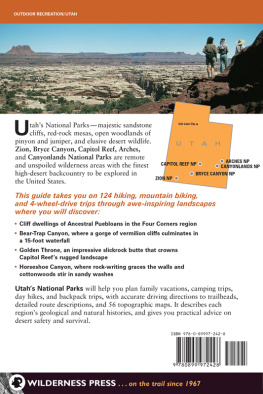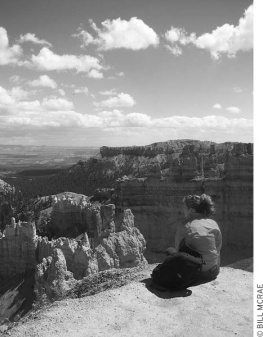A is for Arches
A Utah Alphabet
What do the Mormon Tabernacle Choir, the Sego lily, and the Utahraptor have in common? They are among the many treasures offered by the state of Utah and featured in A is for Arches: A Utah Alphabet. Readers of all ages will enjoy this guided A-Z tour that showcases state symbols and history in an entertaining and educational format.
Beginning readers will enjoy the simple rhymes, while older children discover facts about each topic letter in the sidebar expository.
Well start with Utahs Arches,
made from wind, frost, and rain.
Natures rocky sculptures
An art that cant remain.
Author Becky Halls descriptive rhymes and informative text are highlighted by artist Katherine Larsons vivid, original artwork. From H is for Handcarts to Z is for Zion National Park, A is for Arches presents the history, landscape, and people of the great state of Utah.
A is for Arches
A Utah Alphabet

Written by Becky Hall and Illustrated by Katherine Larson
For Dave, Sarah, and Brooks
BECKY
Dedicated to the DudleysBlair, Di, Ruby, Chase, and Violet
For bravely lending their images to this book and for their
kindness and friendship through these many years.
KATHERINE
A
Utahs most famous arches are near Moab at Arches National Park. These are natures sandstone sculptures, formed by freezing and thawing, by flowing water, and by wind. After many years, arches fall apart because the process that forms them also destroys them. New arches are slowly forming all the time.
The worlds longest natural arch is in Utah; it is not clear where, though. The decision depends on the way an arch is measured. Two arches compete for this honor: Landscape Arch (measuring between 291 and 306 feet) in Arches National Park and Kolob Arch (measuring between 292 and 310 feet) in Zion National Park. Some of this measuring was done by hand, and more recently it was done electronically.
The desert ecosystem where these arches are found is unique. The soil can be so fragile that it never recovers from human footsteps. The only poisonous lizard in the United States, the Gila monster, is found here. Other common animals of the area include mule deer, coyote, gray fox, ground squirrels, collared lizards, and rattlesnakes.
Well start with Utahs Arches, made from wind, frost, and rain.
Natures rocky sculpturesAn art that cant remain.

B
The state insect is the honeybee. On the flag, bees buzz around a yellow hive. An early name for the state was Deseret, which meant honeybee. Utahs nickname is the Beehive State.
The state motto is Industry which means hard work. In 1847 Mormon pioneers settled in Salt Lake City in an attempt to find religious freedom. They had to be resourceful and industrious in order to survive in the harsh desert. They grew their own food, produced as much as they could for themselves, and mined the nearby hills. They tried to be self-sufficient and at one point, they even wanted to be a separate country. Found on the state seal and the flag, it makes sense that Industry was chosen in 1959 as Utahs motto.
Busy Bees, thats what we areOur symbol is the hive.
From mining to technology, this helps our state survive.

C
The worlds first open pit copper mine is near Salt Lake City in Bingham Canyon. Called The Richest Hole on Earth, it covers more than 1,900 acres and is two and one-half miles wide and three-fourths of a mile deep. Since 1906 over six billion tons of material have been removed, including gold and silver. mountain once stood where now there is a deep hole.
The state rock is coal, and the mines are located in central and southeastern Utah. Although Brigham Young and his followers started the mines, many of the miners were brought to Utah from Italy, China, Finland, Greece, Japan, and Mexico. That is how such a variety of people from all over the world settled in central Utah.
The rock and mineral of the state, Coal and Copper, begin with C.
Theyre found in mines both north and south.
Come search for them with me.

D
Utah does have its own Dixie. Before the Civil War began, the states leader, Brigham Young, wanted Utah to be more independent and produce its own cotton. He did not want to rely on the battling southern states, the original Dixie. In October 1861 he sent settlers to southern Utah to start a new Dixie where they could grow cotton. The settlers named their community St. George, after the local leader, George A. Smith. They built a cotton factory that began producing cloth and cotton stuffing by 1867. The factory stayed open until 1910. Today this area is still called Utahs Dixie.
Did you know there are two Dixies? Utah has its very own.
Settled in the 1860s, here cotton once was grown.

E
The state mammal is the Rocky Mountain Elk, which native people called Wapiti. The males or bull elk have antlers that they shed each year. The bulls average six feet in height, nine feet in length, and may weigh as much as 950 pounds. The females are smaller.
The elk live mostly in the mountains, but come into the valleys during the winter, eating grass, leaves, and tender tree branches. At Hardware Ranch in Hyrum the elk are protected. The State Department of Natural Resources feeds as many as 700 elk each winter. This prevents Utahs state mammal from starving and local ranches from losing precious trees and bushes.
Rocky Mountain Elk is E.
At Hardware Ranch its found.
To see this gentle giant beast, you cannot make a sound.
Sh-h-h!

F
Four Corners is the only place in the United States where four states touch. These are Utah, Colorado, New Mexico, and Arizona. They meet on the Navajo Reservation.
F also stands for the Family Research Center in downtown Salt Lake City. It is the number one place in the world for genealogical research. If you want to learn more about your family history, go there or visit their website at www.familysearch.org. They have over two million microfilms of records from more than 97 countries. Many of the records are protected in vaults dug deep into the granite mountainside of Little Cottonwood Canyon outside Salt Lake City.
F is our Four Corners, where four western states all meet.
If you go there any time, youll feel the deserts heat.
G
In 1848, during the pioneers first year in the Salt Lake Valley, there was a disastrous June frost. They replanted crops, but crickets swarmed the fields, devouring everything, even nibbling on ladies cotton skirts. The gulls appeared out of nowhere and ate the bugs, saving the settlers crops.


